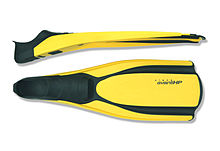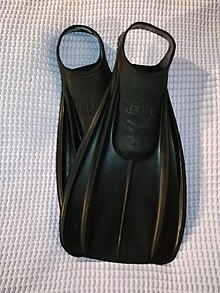Swim fin
Swimming fins or diving fins are swimming aids that increase the propulsion areas of the legs of a swimmer or diver. They enable faster movement or help a learner to better feel the water resistance. Different swim fins are used depending on the swimming style and sport.
Leonardo da Vinci had sketched a pre-form of swimming fins in the form of a finned glove that swimmers should use to move around when caulking ships.
sports
Swimming
During Front Crawl , so-called crawl fins used. When butterfly swimming brings Monofin better performance than the Freestyle fins. When breaststroke may Flap Fins are used, as other fins create less boring when Grätschbeinschlag.
Diving

When diving, diving fins are preferably used, which have larger propulsion areas than kraal fins. When apnea diving and snorkeling with ABC equipment (mask, snorkel and fins) all kinds fins can be used. However, the diving industry has meanwhile developed apnea fins specially adapted to the needs of freedivers. Special duo fins are also used for the underwater sports underwater rugby and underwater hockey. When scuba diving , device fins are mostly used, which can be combined with insulating socks.
Rescue Sports
In rescue sports, fins may be a maximum of 30 cm wide and 65 cm long (including the foot section). Fins are used in the following individual and team competitions:
- Rescuing a doll with fins 50 or 100 m (swimming 25 or 50 m with fins, diving up the doll and 25 or 50 m dragging the doll with fins)
- Rescuing a doll with fins and belt rescuer (50 m swimming with flippers , taking over the doll and 50 m dragging the doll with the belt rescuer)
- Super lifesaver (75 m freestyle, doll pickup, 25 m doll dragging, putting on fins and belt rescuer, 50 m fins swimming with belt rescuer, doll takeover, 50 m dragging of the doll with fins and belt rescuer)
- Rescue team
- Belt rescue team
construction
Commercial swimming fins are made of rubber , EPDM , polyurethane , PVC and other plastics. Glass fiber or carbon fiber reinforced composite materials are also being used more and more frequently .
All fins consist of a shoe-like foot part and a fin blade. A distinction is made depending on the shape of the foot part
- closed fins
- (Also called swim fins, bath fins, swimming pool fins or foot part fins). They are shaped like a shoe, are worn barefoot or with neoprene socks and are therefore usually only used in warm water. In the past (around 1960) mostly made of black or blue rubber and with a triangular blade, today it's mostly an elongated blade on colored plastic.
- Device fins
- (also called open or heel fins). The open heel makes it easier to get into the fins, because device fins are worn with heat-insulating neoprene socks , rock boots or a dry suit with integrated rubber or neoprene socks. The device fins are held on the foot with adjustable rubber or stainless steel spring straps. In the past, device fins were mostly made of black hard rubber. A rather wider blade was provided with water channels. Today, the same material compositions are used for device fins as for swimming pool fins. Many fin manufacturers offer their fin models in both construction variants, i.e. as a foot part and device fin.
Special forms of swim fins

- Split fins
- Fins split lengthways in the middle. According to the manufacturer, the movement should be less strenuous. With these fins, faster movement is mainly possible by increasing the cadence - in contrast to normal fins, where a wider kick leads to acceleration. Divers attribute fatigue-free and cramp-free diving to these fins.
- Apnea fins
- Mostly long and narrow. They enable a strong propulsion even with slow fin movement and have efficiency as the primary goal.
- Monofins
- They are used for deep and distance diving as well as for fin swimming, but have also recently been used increasingly for apnea diving. In swimming , the monofin is used as an aid to learn to swim with butterflies. With the monofin, both feet are in a large fin, with which dolphin-like movements of the whole body generate propulsion.
- Rescue Fins
- Fins for the rescue sport , the underwater rugby and underwater hockey . They are used for competition and are made of GRP or CFRP . The maximum size in the competition is set at 30 cm in width and 65 cm in length including the foot (both according to ILS and German regulations).
- Flap Fins (also called swimming shoes)
- Flippers for breaststroke swimming. Flap fins are particularly suitable for learning to kick the leg while breaststroke swimming. The water resistance in the impact phase is increased by enlarged propulsion surfaces and can be better felt by the learner. A user learns a symmetrical leg kick right from the start, so that swimming errors such as the “scissors kick” or the so-called “equinus” are prevented.
- Force fins
- A strongly widened elastic device fin with a modified foot section, which is supposed to generate more propulsion.
- Jet fins
- Developed in 1967 by Beuchat International . A special form of the device fin that has been a reference for divers worldwide for two decades.
Web links
Individual evidence
- ↑ a b c Which fin would you like? ( Memento of March 4, 2016 in the Internet Archive ), Linus Geschke, Atomic Aquatic and Dive2gether, accessed on September 10, 2012.
- ↑ Rescue Sports Regulations - Swimming Pool Disciplines . DLRG material office.
- ↑ a b c d e Herbert Gfrörer, Armin Süss: fins . ( Memento of December 14, 2010 in the Internet Archive ) (PDF; 1.9 MB) accessed on September 10, 2012.




